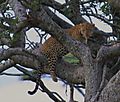Leopard
Parent page
On this page
Introduction to Leopards
Description and Characteristics
African leopards have a great variation in coat color, depending on location and habitat, having pale yellow to tawny dark circular rosettes on the flanks, back and tail. They have solid spots on their faces and whitish colur below. Black forms occur.
Leopards are one of the most common cats in Africa, however, they are also the most reclusive and as such are difficult to spot, often blending in with their surroundings. They are nocturnal, most active at dusk and tend to hunt in the evenings and early mornings, another reason why they are not often seen.
Adults are generally solitary animals with the males and females only coming into contact with one another to mate.
Feeding/drinking Habits
Leopards are carnivores and hunt small antelopes, warthogs, hyraxes and monkeys/baboons, their diet also includes birds and repiles. They store their kill up trees to keep it safe from Lions and Hyenas.
Habitat
They can be found in most of sub-Saharan Africa. Their habitat is wide and they can be seen in semi-arid land, scrubland, Bush, savannahs, mountain lowland rainforests, riverine forest and rocky outcrops. They like to sun themselves on termite mounds or rocky outcrops.
Size and Lifespan
Male leopards are larger than females, weighing up to 130-200 lbs, whilst females weigh between 75 and 88 lbs. They grow up to 2.3 meters long at stand approx 28 inches at the shoulder for adults. Generally they live for 15-20 years in the wild
Reproduction
Leopards breed all year round, and can have between 2 to 6 cubs. The females will raise the cubs by themselves. The gestation period is anything from 90-112 days and they will become independant adults at between 18 to 22 months. Leopard cubs are kept hidden for the first couple of months and at about 4 months old the mother starts to train the cubs to hunt small animals.
Predators and Threats
Humans have been and a remain the main threat to the survival of leopards, whose numbers, whilst currently numerous, are decreasing. Human induced habitat loss, fragmentation/degradation, hunting/gathering, pest control is having a continued impact in the survivals of leopards.
Safari Tip: When on safari and spotting leopards, look for what appears to be a short branch (moving slightly) hanging down from a large limb of a tree, this is how the leopard positions its tail when resting.

















